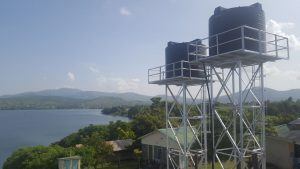Efforts for improving maternal and newborn health (MNH) often focus on implementing specific measures of maternity care, strengthening health systems and increasing women’s demand for giving birth in health care facilities—sometimes with little or no attention paid to the conditions of the places in which women give birth. Among these conditions is the availability—or lack—of clean water, sanitation and hygiene (WASH) facilities.
Inadequate access to clean water
A 2015 World Health Organization (WHO) rapid assessment of WASH coverage in health care facilities in 54 low- and middle-income countries found that 38% of these facilities lacked access to an improved water source, or one that is likely to be protected from outside contamination. Furthermore, 35% did not have water and soap for handwashing, and 19% did not have improved sanitation, or a system that hygienically separates human excreta from human contact. The percentage of facilities without improved water rose to 42% when only countries in the African region were considered.
This is consistent with the situation in some parts of Kenya, where a 2016 multi country analysis of WASH in the childbirth environment found only 18% of women delivered in an environment with improved water. UNICEF in Kenya has been supporting the government of Kenya over the past year to improve WASH conditions in select health facilities in the MNH high-burden districts of Kakamega, Homa Bay, Turkana, Garissa and Nairobi.
A clean water, sanitation and energy plan
 To identify health facilities in great need of improved WASH facilities, UNICEF in partnership with United Nations Office for Project Services (UNOPS) supported the government in undertaking a comprehensive assessment of health facilities to determine their WASH birth environment. One example is Homa Bay County’s Nyandiwa Health Centre, which—despite being on the shores of the second largest fresh water lake by area in the world—had no reliable supply of clean water. Nyandiwa was among 50 priority health facilities in the five districts that were eventually selected for a clean water and sanitation improvement plan.
To identify health facilities in great need of improved WASH facilities, UNICEF in partnership with United Nations Office for Project Services (UNOPS) supported the government in undertaking a comprehensive assessment of health facilities to determine their WASH birth environment. One example is Homa Bay County’s Nyandiwa Health Centre, which—despite being on the shores of the second largest fresh water lake by area in the world—had no reliable supply of clean water. Nyandiwa was among 50 priority health facilities in the five districts that were eventually selected for a clean water and sanitation improvement plan.
The improvements at Nyandiwa entailed rehabilitation and upgrading of existing water supply system to provide sustained WASH services to the health facility. An automatic water pump on the shores of Lake Victoria pumps water from the lake to raised water tanks with a combined capacity of 20,000 liters. These act as a reservoir and are connected through a piped system to various water delivery points within the health center, including the delivery room.
A UNICEF-supported green energy project has also installed a solar system which provides reliable energy to the water pumping equipment, as well as lighting to the sanitation and hygiene facilities. Health facility managers and workers were trained on hygiene promotion as well as on operation and maintenance of the water system for sustained delivery of WASH services. For example, the health center has trained and assigned a Community Health Assistant to conduct routine operation and maintenance of the WASH facilities. The health center also conducts regular cleaning of the rain water harvesting tanks which provide clean drinking water for the staff and patients.
Impact on maternal newborn health
At health facilities, hygiene workers deliver messages promoting safe waste disposal, handwashing at critical times and drinking safe water through sessions with mothers during routine maternal, newborn and child health visits as well as through posters and fliers. Although there is a dearth of rigorous research quantifying the impact of WASH on MNH outcomes, available evidence, based on biological plausibility, suggests WASH interventions could improve MNH. It is therefore hoped the improvement in WASH in Nyandiwa and the other 49 health facilities will contribute to improvements in MNH service utilisation, and ultimately better health outcomes for mothers and newborns. Governments should develop plans and frameworks to continue improving WASH in health facilities and ensure that adequate financial resources are available to realize these goals.
—
Join the conversation on World Water Day by using #WorldWaterDay.
Read about giving birth without clean water.
Photo Credit: Eric Sakwa, UNOPS Engineer, Kenya
